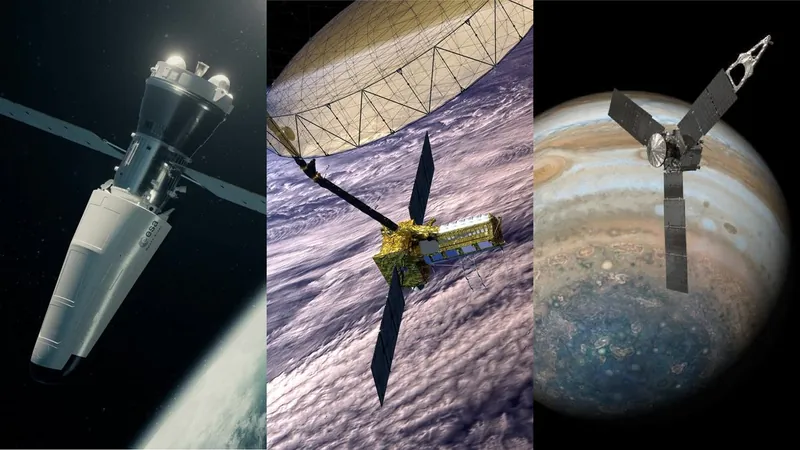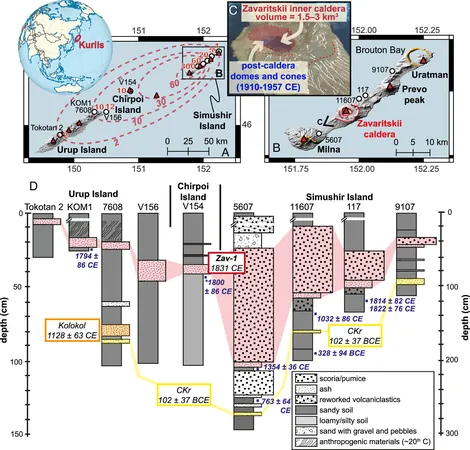
2025: A Year of Groundbreaking Space Adventures Awaits!
2024-12-30
Author: John Tan
2025: A Year of Groundbreaking Space Adventures Awaits!
The dawn of 2025 promises to be a thrilling period for space enthusiasts, brimming with ambitious and noteworthy missions that will push the boundaries of human exploration. From moon landings to asteroid sample retrievals, here’s a sneak peek at the most exciting space ventures scheduled for this year.
Moon Landing Frenzy: Blue Ghost 1 and Intuitive Machines' IM-2
Kicking off January, Texas-based Firefly Aerospace will ignite excitement with its “Ghost Riders in the Sky” mission. The company aims to send the Blue Ghost 1 lander to Mons Latreille, a volcanic formation on the lunar surface, loaded with 10 vital NASA payloads. This mission will span approximately 14 Earth days while Blue Ghost 1 collects valuable data on the moon's regolith and its interactions with solar wind and Earth's magnetic field. To wrap up its mission, expect stunning images of lunar sunsets and analysis of surface changes at dusk.
Not to be outdone, Intuitive Machines plans to land its IM-2 spacecraft at the moon’s south pole as early as February. Equipped with a drill and mass spectrometer, IM-2 will analyze the moon's volatiles, essential for future human missions to the lunar surface under NASA’s Artemis program. Additionally, it will deploy Lunar Trailblazer, a small satellite that will map water deposits, crucial for identifying future landing sites.
SpaceX to Test In-Orbit Propellant Transfer
March 2025 will mark a pivotal moment for SpaceX with a daring test scheduled to transfer propellant between two Starship vehicles in low Earth orbit. This bold maneuver, which involves launching two Starships within weeks of each other, aims to prove that the spacecraft can be efficiently refueled in space—a crucial capability for future missions to the moon and Mars. NASA's aspirations for Artemis 3, projected to send humans back to the moon no earlier than mid-2027, heavily rely on this technology.
NASA and ISRO Team Up for Earth Science
Another significant undertaking in March involves a collaborative effort between NASA and India's ISRO, launching the NISAR mission to observe Earth's surface. This innovative satellite will utilize advanced radar technology to monitor land and ice movements, offering insights into natural disasters and environmental changes. Both countries are also set to make history with Axiom Mission 4, which will send India’s first astronaut to the International Space Station around April 2025.
Delayed Mars Exploration: Blue and Gold Satellites
NASA’s ESCAPADE mission, comprising two satellites named Blue and Gold, aims to explore Mars' atmospheric loss. After a delay from its initial launch window in October 2024, these satellites are now adjusted for a spring 2025 launch. They will orbit at varying altitudes to gather crucial data on the Red Planet's plasma and magnetic fields, crucial for understanding its atmospheric evolution.
China’s Ambitious Dual Mission
China is poised to make headlines with its Tianwen-2 mission, set to launch in May 2025. This audacious program plans not only to collect samples from the near-Earth asteroid 469219 Kamo'oalewa but also to embark on a journey to a comet. This asteroid, theorized to be ejected from the moon’s surface, has intriguing scientific implications, and China aims to explore its composition and return samples to Earth before venturing into deep space.
The Final Chapter for Juno on Jupiter
NASA's beloved Juno spacecraft, which has been unraveling the mysteries of Jupiter since 2016, is slated to meet its end in September 2025. As it descends into the planet's dense atmosphere, the mission will ensure that no Earthly microbes tarnish the integrity of Jupiter’s moons, particularly Europa, a promising candidate in the search for extraterrestrial life.
Europe’s Space Rider: A New Era in Robotic Labs
Rounding out 2025’s innovations is ESA's Space Rider, a reusable robotic laboratory. Set to launch in the third quarter of 2025, this cutting-edge facility will conduct experiments in microgravity before making a controlled landing back on Earth. This mission is part of a broader strategy to provide affordable access to low Earth orbit for commercial clients, ensuring Europe remains a key player in the burgeoning space economy.
With these missions on the horizon, 2025 is shaping up to be an exhilarating year for space exploration, as humanity continues its relentless pursuit of knowledge beyond our planet! Keep your eyes on the stars—this year promises to be out of this world!



 Brasil (PT)
Brasil (PT)
 Canada (EN)
Canada (EN)
 Chile (ES)
Chile (ES)
 Česko (CS)
Česko (CS)
 대한민국 (KO)
대한민국 (KO)
 España (ES)
España (ES)
 France (FR)
France (FR)
 Hong Kong (EN)
Hong Kong (EN)
 Italia (IT)
Italia (IT)
 日本 (JA)
日本 (JA)
 Magyarország (HU)
Magyarország (HU)
 Norge (NO)
Norge (NO)
 Polska (PL)
Polska (PL)
 Schweiz (DE)
Schweiz (DE)
 Singapore (EN)
Singapore (EN)
 Sverige (SV)
Sverige (SV)
 Suomi (FI)
Suomi (FI)
 Türkiye (TR)
Türkiye (TR)